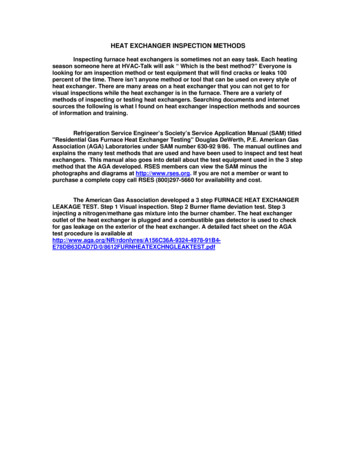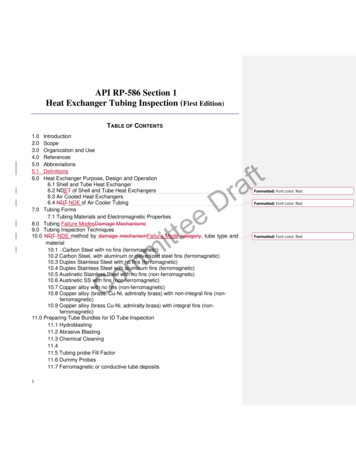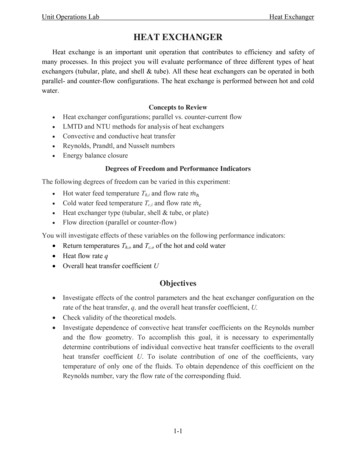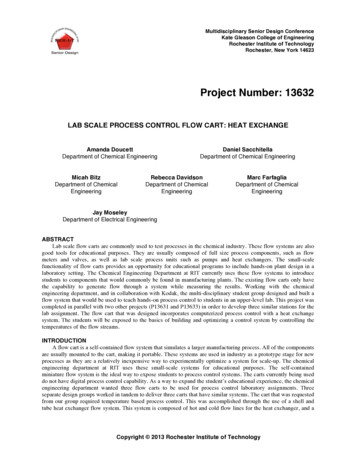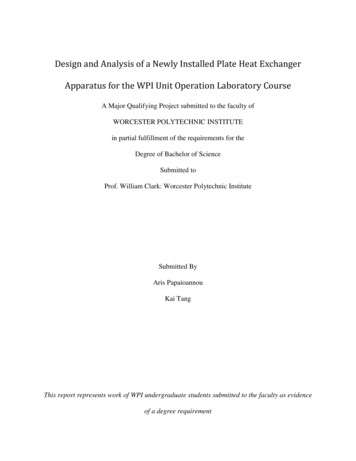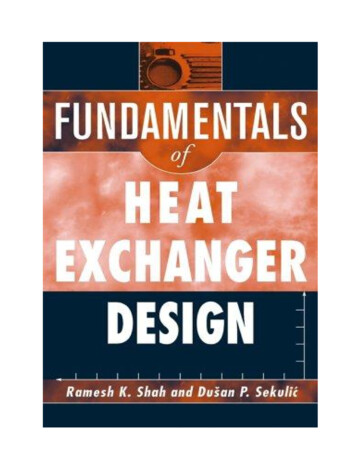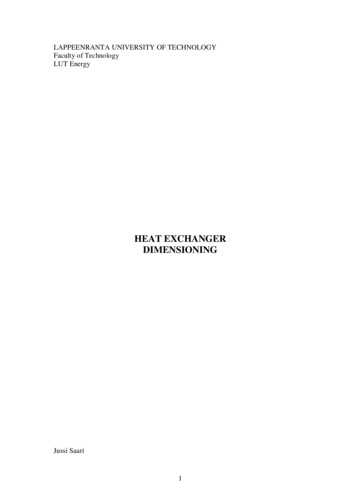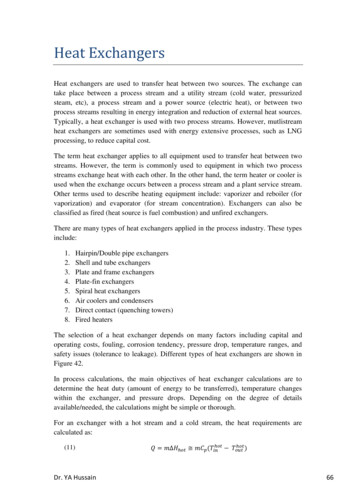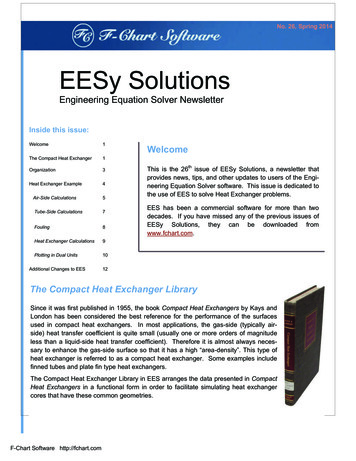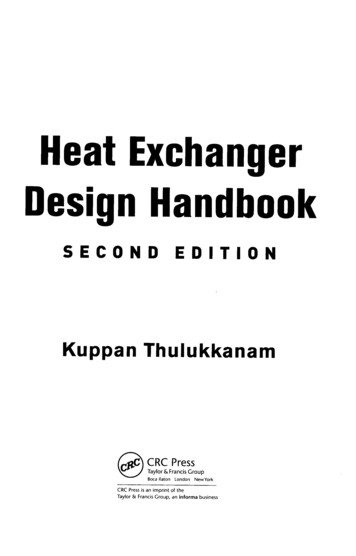
Transcription
HeatExchangerDesign HandbookSECONDEDITIONKuppan ThulukkanamCRC PressTaylor & Francis GroupBoca RatonCRC Press isLondonNew Yorkanimprint of theTaylor & Francis Croup, an informa business
r1HeatExchangers: Introduction, Classification,1and Selection1.1Introduction11.2Construction of Heat Exchangers11.3Classification of Heat ar Heat1.3.1.2Plate Heat1.3.1.3Extended t Contact Heat Exchangers16Contact-Type Heat ExchangersClassification according to Surface CompactnessClassification According to Flow Arrangement171.3.4.1181.3.2.21.3.3210to Transfer ProcessHeatRegenerativeClassification nterflow Exchanger1.3.4.3CrossflowClassification19to PassArrangementsMultipass ExchangersClassification According to ClassificationAccordingto HeatTransfer 122Other Classifications221.3.8.1Micro Heat Exchanger1.3.8.2Printed Circuit Heat Exchanger1.3.8.3Perforated Plate Heat1.3.8.4Surface Heat1.3.8.51.421of CryocoolersExchangerExchanger252527Selection of Heat Exchangers281.4.1Introduction281.4.2Selection Criteria29301.4.2.1Materials of Construction1.4.2.2Operating Pressure1.4.2.3Flow Rate311.4.2.4Flow Arrangement311.4.2.5Performance Parameters: Thermal Effectiveness andPressureDropsandTemperature3031
ContentsVIIITendencies1.4.2.6Fouling1.4.2.7Types and ction, Cleaning, 10 Fabrication1.4.2.1132of FluidsTechniquesType for Intended ApplicationsChoice of UnitRequirements of Heat Exchangers333334References34Suggested Readings35Bibliography35Heat39Exchanger Thermohydraulic Fundamentals2.1Heat2.2Heat2.2.1Exchanger Thermal Circuit and OverallHeat TransferExchangerAnalysisEnergy Balance Equation2.2.2Heat Transfer2.2.3Basic MethodsConductanceEquationMethods414141to Calculate Thermal2.2.3.1e-NTU Method2.2.3.2F-NTU, Difference Correction FactorMethod2.2.3.42.2.4v /-F45Method48Some Fundamental RelationshipstheExchangerforto Characterize"Subdesign" Condition2.3Thermal Effectiveness Charts2.4and FlowSymmetry Property394950Reversibilityand Relation betweenthe Thermal Effectiveness of Overall Parallel and Counterflow HeatExchangerGeometries522.4.12.52.6Symmetry Property2.4.2Flow ReversibilityTemperature Approach, Temperature Meet, and Temperature2.5.1Temperature Cross for Other TEMA ShellsThermal Relation Formulas for Various FlowArrangements5252Cross5456and low572.6.3Crossflow Arrangement572.6.3.1Unmixed-Unmixed Crossflow572.6.3.2Unmixed-Mixed Crossflow572.6.3.3Mixed-Mixed Crossflow572.6.3.4Single572.6.42.6.5orMultipleRows in CrossflowThermal Relations for Various TEMA Shells and Others722.6.4.1 Shell742.6.4.2TEMA F Shell2.6.4.3TEMA G Shell2.6.4.4TEMA//Shell2.6.4.5TEMA J Shell2.6.4.6TEMA X Shell79orSplit-Flow Exchanger7981orDivided-Flow ShellThermal Effectiveness of Multiple Heat8190Exchangers90
hangersExchangersMultipass Crossflow Exchangers2.6.6.1Multipassing with Complete Mixing2.6.6.2Two Passes with One Fluid UnmixedCross-Counterflow2.6.6.392between Passesthroughout,Thermal Effectiveness ofTube Heat98ArrangementTwo Passes with Both Fluids UnmixedCross-CounterflowChapter 394Two Passes with Both Fluids rangementin Each Pass and One Fluid Pass Shell iography115Heat3.1Exchanger3.31173.1.1117Design MethodologyProcess/Design Specifications3.1.1.2Exchanger Construction1183.1.1.3Surface Selection119SpecificationThermohydraulic Design3.1.2.1Basic Thermohydraulic Design119MethodsThermophysical Properties1193.1.2.3Surface Geometrical1193.1.2.4Surface CharacteristicsDesignHeat Exchanger DesignProperties119120120a Compact ExchangerRatingRating of a Shell and Tube ExchangerofSize ofa122Sensitivity AnalysisSizing of a Compact3.3.2.4Sizing of a Shell and Tube Heat ExchangerHeat Exchanger OptimizationSolution to ExchangerProblemSizingProblem3.5.1aThermalDesign Computer Program122122123123Program Logic124Structure for a Shell and Tube125GuidelinesonExchanger Pressure-Drop Analysis3.5.1.1Pressure-Drop Evaluation for Heat -Drop Analysis, Temperature-Dependent Fluid Properties,Performance Failures, Flow Maldistribution, Fouling, and Corrosion3.4.2122122to theOverall Structure of3.4.1.1121121Exchanger3.3.2.3Computer-Aided amentals of Heat Exchanger3.1.23.2Thermal125125125-
ContentsXPressure3.5.1.3Shell and Tube Heat1273.5.1.4Pressure127Drop in the NozzlesTemperature-Dependent Fluid Properties .53.5.23.63.7128Pressure3.5.3Performance 6Corrosion Allowance130132Cooperative Research Programs3.6.1HTRI3.6.2HTFSonHeatExchanger Design132of HeatDesignExchangersExchanger Design133Uncertainties in Heat3.7.1.13.7.1.2UncertaintyUncertainty133in Process Conditionsin thePhysical Properties of orm Flow Passages1353.7.1.5Uncertainty in ue toDesign CorrelationsThermodynamically DefinedUnmixed Flows for Crossflow HeatExchangers, after Digiovanni3.7.1.73.7.2132132Uncertainties in Thermal3.7.1and WebbNonuniform Heat Transfer ty3.7.1.10Miscellaneous EffectsPath136136the Air Side of Compact Tube-Finon137inFouling137137Determination of Uncertainties1373.7.2.1Computational Procedures1373.7.3.2Additional Surface Area3.7.3.3NomenclatureChapter 4126Drop through a Heat ExchangerExchangersDrop due to Flow Turning3.5.1.2Required due to Uncertainty. 139Additional Pressure Drop due to ct4.1HeatExchangers145Classification and Construction Details of Tube-FinCompact HeatExchangers4.1.14.1.24.1.3ExchangersTube-Fin Heat Exchangers4.1.3.1Specific Qualitative Considerations for Tube-Fin ristics of Compact Heat ExchangersConstruction Types of Compact HeatIndividually FinnedContinuous Finson a TubeTubesArray1451461461471481481514.1.4.1Tube: Primary Surface1514.1.4.2Fin:151SecondarySurface
1524.1.4.3Headers4.1.4.4Tube-to-Header Joints4.1.4.5Casings orCircuiting4.1.4.6152152Tube Frame152and4.1.4.7Exchangers for Air Conditioning4.1.4.8Radiators4.1.4.9Effect of Fin4.1.4.10One-Row Radiator4.1.4.11Manufacture of Continuous Finned Tube ngers4.1.5152Surface Selection1564.1.5.1Qualitative Considerations1564.1.5.2Quantitative Considerations157Exchangers1574.2.1PFHE: Essential Features1584.2.2Application for4.2.3Size1594.2.4Advantages of PFHEs1594.2.5Limitations of FlowPlate-Fin Heat4.2.9158Fouling ServiceArrangementsFin Geometry Selection160160and Performance Factors1604.2.9.1Plain Fin4.2.9.2Plain-Perforated Fin4.2.9.3Offset4.2.9.4Serrated Fins4.2.9.5Herringbone or Wavy Fin1634.2.9.6Louver Fins1634.2.9.7Pin Fins1644.2.9.8FINStrip161162Fin163:165Corrugation Code4.2.10Corrugation Selection1664.2.11Materials of Construction1664.2.11.1Aluminum1664.2.11.2Other Manufacture, Inspection,4.2.14Brazed Aluminum Plate-Fin HeatControl166Exchanger (BAHX)1664.2.14.1ALPEMA Standard1664.2.14.21694.2.14.3ApplicationsHeat gh Estimation of the Core4.2.14.6Provisions for Thermal4.2.14.7MechanicalHeat169ExpansionDesign of Brazed171Volumeand Contraction173Aluminum rials of yAssuranceInspection174Programand ThirdParty174
Contentsxii4.2.15174of EX: Brazed ALuminumComparison174of Salient FeaturesEXchangerof Plate-Fin Heat Exchangers175and Coil-Wound Heat4.2.164.3ExchangerHeat Exchanger Specification Sheet for Plate-FinHeatExchanger4.3.1.24.3.24.3.3175Surface Geometrical Parameters: General4.3.1.1TubularHydraulic Diameter, DhSurface Area Density a andHeat Exchangers175177c1774.3.2.1Tube Inside1774.3.2.2Tube Outside178184Compact Plate-Fin Exchangers4.3.3.1Heat Transfer Area184Components of Pressure LossFactors Influencing Tube-Fin Heat Exchanger eral Layout4.4.3Number of Tube Rows1874.4.4Tube Pitch1884.4.5Tube-Fin Variables188Height188and Fin PitchFinned Tubes with Surface ayer4.4.9Contact Resistance in Finned Tube HeatContinuous Finned Tube4.4.9.2Tension-Wound Fins4.4.9.3Finned TubeIntegralInduced DraftversusonLengthExchangersInduced Draft4.4.10.2Forced Draft189190190ExchangerCircular Tubes190190191Forced Draft4.4.10.1191191Fundamentals of Finned Tube HeatExchangers191Heat Transfer and Friction Factor Correlations for Crossflowover4.5.2Disturbances and Characteristic ty urface Geometrical Relations4.3.1174Staggered Finned Tube Banksand/Factors191The j1924.5.2.1Bare Tube Bank4.5.2.2Circular Tube-Fin4.5.2.3Continuous FinonCircular Tube1964.5.2.4Continuous FinonFlat Tube198192Arrangement193ArrayCorrelations for j and /factors of Plate-Fin HeatExchangers1984.6.1Offset Strip Fin Heat Exchanger4.6.2LouveredFin2004.6.3Pin Fin Heat201Fin198ExchangersEfficiency2024.7.1FinLength for SomeConfigurations4.7.2FinPlate-Fin HeatExchangerFin202Efficiency4.7.2.1Circular Fin4.7.2.2Plain Continuous Fin202202onCircular Tubes204
Contentsxiii4.8Rating of a Compact ExchangerRating of Single-Pass Counterfiow and Crossfiow Exchangers4.8.2Shah's Method for Rating of Multipass Counterfiow and4.8.1Crossfiow Heat4.9Core Mass4.9.2Procedure of Plate-Fin Exchangers and ConstraintsOptimizationWeight MinimizationEffect of4.10.1SizingaLongitudinalon211Heat ConductionLongitudinal ConductiononInfluenceThermal Effectivenesson4.11ComparisonExchangers213of Thermal Performance ofCompactAirversus4.11.1.14.11.2213213Water CoolingAir214Cooling215Construction of ACHE4.11.2.1216Tube Bundle Construction2164.11.3American Petroleum Institute Standard API 661/ISO 137064.11.4Problems with Low-Temperature Environments. 225Control225Forced Draft versus Induced Draft2254.11.5.1Forced Draft2254.11.5.2Induced Draft225Recirculation2264.11.7Design Aspects4.11.7.1 Design Variables4.11.7.2 Design Air Temperature4.11.8 Design Tips4.11.8.1 Air-Cooled Heat Exchanger DesignChapter 5HeatAir-Cooled Heat Exchanger (ACHE)4.11.1212Various ocity EquationSizing of a led Heat Exchanger Data/Specification Sheet2294.11.8.3Performance Control of 6Shell and Tube Heat Exchanger Design2375.1Construction Details for Shell and TEMA Standard2375.1.1.2ANSI/API Standard 660237Tubes2385.2.1Tube Diameter5.2.2Tube Wall Thickness2395.2.3Low-Finned Tubes2405.2.4Tube2405.2.5Means of Fabricating Tubes2405.2.6DuplexBimetallic Tubes2405.2.7Number of TubesLengthor239241
Contentsxiv5.2.8Tube Count2415.2.9U-Tube2415.2.9.15.3U-Tube U-Bend241242Tube Pitch2425.3.2Tube Layout2425.3.2.1242Triangular and Rotated Triangular ArrangementsSquare and Rotated Square ArrangementsBaffles2432435.4.1Classification of Baffles2435.4.2Transverse Baffles2435.4.2.1Segmental Baffles2435.4.3Disk andDoughnut Baffle5.4.4Orifice Baffle2482475.4.5No Tubes in Window2485.4.6LongitudinalBaffles2495.4.7Rod Baffles5.4.8NEST Baffles and249TubeEgg-CrateNon-Segmental Baffles5.4.9Grimmas Baffle5.4.10Wavy5.4.11Baffles for Steam Generator TubeSupport249250251Bar Baffle251SupportTubesheet and Its Connection with Shell and Channel2512525.5.1Clad and Faced Tubesheets2535.5.2Tube-to-Tubesheet Attachment2535.5.3Double Tubesheets2535.5.3.15.5.45.6per entsTubeTypesof Double TubesheetDesignsDemerits of Double Tubesheets253256Tube Bundle2565.6.1Bundle Weight2565.6.2Spacers, Tie-Rods, and Sealing Devices2565.6.3Outer Tube Limit2565.7Shells2585.8Pass Arrangement5.8.1Tubeside Passes2585.8.22585.8.1.1Number of Tube Passes2585.8.1.2End Channel and Channel Cover260Shellside Passes2625.8.2.1Expansion Joint2635.8.2.2Drains and Vents2635.8.2.3Nozzles andImpingement Protection5.9Fluid5.10Classification of Shell and Tube Heat5.11Properties andAllocationExchangersDescribing Heat Exchanger Types5.11.1 Fixed Tubesheet Exchangers5.11.2 U-Tube Exchangers5.11.2.1 Shortcomings of U-TubeExchangers5.11.3 Floating Head 1.3.1Sliding Bar/Surface5.11.3.2271Kettle-Type Reboiler272
Contentsxv5.12Differential Thermal5.13TEMA Classification of Heat5.14Shell and Tube Heat Exchanger Selection5.14.1 Shell TypesBasedService Conditionon2722722745.14.1.2 TEMA F Shell2745.14.1.3TEMA G, H Shell2755.14.1.4TEMA G ShellSplit Flow Exchanger5.14.1.5 TEMA H Shell or Double Split Flow Exchanger2755.14.1.6 TEMA J Shell2765.14.1.7ororTEMA K ShellDivided FlowKettleorTypeExchangerReboiler2762775.14.1.9 Comparison of Various TEMA Shells278Front and Rear Head278DesignsDesignationsfor Head Types2785.14.3TEMA Specification SheetShellside Clearances2795.15.1Tube-to-Baffle-Hole Clearance2795.15.2Shell-to-Baffle Clearance2795.15.3Shell-to-Bundle Clearance2792795.15.45.16Bypass LanesDesign Methodology5.16.1282282Shellside Flow Pattern5.16.1.1Shell Fluid2822845.16.1.4 Flow Fractions for Each Stream2855.16.1.5285Shellside Performance5.16.3Guidelines for STHEof Shell and Tube HeatDesignThermalDesignHeata286287ExchangerShell and Tube HeatExchangerProcedureAuxiliary Calculations, Step-by-Step sure-Dropto287288Design Method: Bell-Delaware MethodShellside Heat Transfer and5.16.6.1286DropDesignSpecify the Right5.16.5.2 Detailed5.16.5.3285DesignConsiderations for5.16.5.1285ExchangersHeat Transfer Coefficient and PressureGuidelines for Shellside5.16.4.15.16.6282LeakageShellside Flow 2and5.16.1.2 Bypass Prevention and Sealing Devices5.16.3.15.172755.14.1.8 TEM X Shell5.14.2.15.15272TEMA E n Factors291293297Determine Heat TransferCorrection Factors2985.16.6.2Shellside Heat Transfer Coefficient and Pressure5.16.6.3Tubeside Heat Transfer Coefficient and Pressure Drop3045.16.6.4Accuracyof the Bell-Delaware Method3085.16.6.5Extension of the Delaware Method to Other GeometriesDrop301308Shell and Tube Heat3105.17.1Exchangers with Non-Segmental BafflesPhillips RODbaffle Heat portantExchanger ConceptsBenefit: Elimination of ShellsideFlow-Induced Vibration311Proven RODbaffle311Applications
ContentsXVI5.17.1.4 Operational Characteristics3115.17.1.5 Thermal Performance3115.17.1.65.17.2Design and Rating Program Available312312EMbaffle Heat ExchangerApplication of EMbaffle Technology5.17.2.2 Design5.17.2.3 Benefits of EMbaffle TechnologyHelixchanger Heat Exchanger5.17.3.1 Merits of Helixchanger Heat 17.5ApplicationsHelixchangerExchanger: Configurations315317Twisted Tube antages3185.17.4.3 Merits of Twisted Tube Heat Exchanger319End Closures319Breech-Lock Closure319Dismantling Jig320Taper-Lok ClosureHigh-Pressure End ClosuresAppendix A5.17.63205.17.73205.A. 15.A.25.A.35. A.45.A.56314315315Heat5.17.5.2 Easy Installation andChapter3145.17.3.4 Performance5.17.5.15.A312321Reference Crossflow VelocityDesignof Disk andasper TinkerDoughnut Heat321Exchanger5.A.2.1Design5.A.2.2Heat Transfer5.A.2.3Shellside Pressure5.A.2.4Shortcomings of Disk and M RF Radial Flow Gas Heat Exchanger3265.A.3.1327TubeLayoutClosed Feedwater Heaters3275.A.4.1Low-Pressure Feedwater Heaters3285.A.4.2High-Pressure Feedwater Heaters328Steam Surface Condenser3295.A.5.1Mechanical3305.A.5.2Parts of Condenser5.A.5.3Condenser Tube Material3315.A.5.4Condenser rences333Suggested 26.1.36.1.46.1.5Regeneration PrincipleRegenerators in Thermodynamic SystemsGas Turbine Cycle with RegenerationWaste Heat Recovery ApplicationBenefits of Waste Heat Recovery6.1.5.1Direct Benefits337337and Others337337338338338
xviiContents6.26.1.5.2Indirect Benefits6.1.5.3FuelCombustion AnPreheating3396.2.13396.2.2RecuperatorMerits ofRecuperators6.2.3RegeneratorTypes of d-Bed-Type Regeneratoror6.2.4.1Fixed-Matrix Surface Geometries6.2.4.2Size6.2.4.3Merits of Fixed-Bed342342342RegeneratorsRotary Regenerators6.2.5.16.2.5.2343Salient Features of343Rotary Regeneratorsfor Gas Turbine6.2.5.3Rotary RegeneratorsTypes of Rotary Regenerators6.2.5.4Drive toApplications6.5Rotary RegeneratorsOperating Temperature and Pressure3456.2.5.56.2.5.6Surface Geometries for Rotary Regenerators3456.2.5.7Influence of3456.2.5.8Size6.2.5.9Desirable Characteristics for6.2.5.10Total Heat3466.2.5.11Merits347Hydraulic neratorsof Regenerators346Rotary Regenerative Air Preheater6.3.1Design Features6.3.2Heating Element Profiles3476.3.3Enameled Elements3496.3.4Corrosion and Fouling3496.3.5Heat3496.3.6Seals andExchanger348349BasketsSealing System Components3506.3.6.1Radial Seals and Sector Plates3506.3.6.2Axial Seals and3516.3.6.3Circumferential Seals and Circumferential SealingSealing Plates3516.3.7Leakage6.3.8Alstom Power Trisector351Ljungstrom AirPreheater3526.5.1Compatibility3526.5.2Economic Benefits3536.5.2.13536.5.4of351Recuperators and RegeneratorsConsiderations in Establishing a Heat Recovery SystemComparison6.5.36.6345345Ring6.4339Heat Exchangers Used for Regeneration6.2.1.16.3Savings339due towith the Existing Process SystemCapitalCostsLife of theExchangerMaintainability352353353Regenerator Construction Material6.6.1Strength and Stability at the Operating Temperature3536.6.2Corrosion Resistance3556.6.3Ceramic Heat3556.6.4Exchangers6.6.3.1Low Gas PermeabilityCeramic-Metallic Hybrid Recuperator6.6.5Regenerator Materials for Other than Waste Heat Recovery355354355355
Contentsxviii6.7356Correlation for j and/357ThermalDesign TheoryRegenerator Solution Techniques6.8.1.1Open Methods: Numerical3586.8.13596.7.26.8356Thermal Design: Thermal-Hydraulic FundamentalsSurface Geometrical Properties6.7.1Finite-Difference Method6.8.2Basic ThermalMethods3596.8.3Coppage and Longon Model for a Rotary Regenerator6.8.3.1Thermal Effectiveness3606.8.3.2364DesignHeat Transfer6.8.4Parameter Definitions6.8.5Classification of6.8.6Additional Formulas los Method forRegenerator3706.8.9Influence of Longitudinal Heat Conduction in the Wall3716.8.9.1Bahnke and Howard Method3726.8.9.2Romie's Solution3726.8.9.3Shah's Solution to Account for theBalanced andCounterflow 6.8.113746.8.13Regenerator Design MethodologyPrimary Considerations Influencing DesignRating of Rotary Regenerators6.8.14Sizing of Rotary nced CounterflowConduction EffectCarryoveronThermal rSymmetric Counterflow RegeneratorReduced Length-Reduced Period (A-TI) Method6.8.6.16.9359359Closed Methods6.8.1.2DesignSingle-Bed374374374375and Dual-Bed FixedRegenerators375Rotary 3Drive for the Rotor3766.9.2.4Thermal Distortion and Transients3776.9.2.5Pressure Forces377Industrial375DesignRegenerators and HeatRecoveryExchangersHeat RecoveryDevices6.10.1Fluid-Bed Regenerative Heat6.10.2Fluidized-Bed Waste6.10.3Vortex-Flow Direct-Contact Heat6.10.4Ceramic Bayonet Tube Heat6.10.5Regenerative6.10.6Porcelain-Enameled Flat-Plate Heat6.10.7Radiation nersHeatMerits of Heat-Pipe conomizer3826.10.10Thermocompressor3826.10.11 MuellerTemp-Plate Energy Recovery Banks383
xixContents6.11Exchangers for Space HeatingWorking Principle3846.11.2Construction3856.11.3Rotor RotaryHeatDrive386and Control UnitSystemCleaning 391Plate Heat7.1ExchangersSpiralPlate Heat393ExchangersPlate Heat3937.1.1Exchanger Construction: GeneralFlow Patterns and Pass Arrangement7.1.2Useful Data3967.1.3Standard Performance Limits7.2Benefits Offered7.3Comparison7.4and394PHEon397by Plate Heat ExchangersbetweenaPlate HeatExchanger397andShell and Tube HeataExchanger399Plate Heat Exchanger: Detailed Construction Features3997.4.1399Plate7.4.1.1Plate Pattern7.4.1.2Types of Plate7.4.1.3399400Corrugation400PatternIntermating Troughsor Herringbone Trough7.4.1.4Chevron7.4.1.5Plate MaterialsPattern4004007.4.2Gasket Selection7.4.3Bleed Tie Bolts4027.4.7Connector 5Brazed Plate Heat7.6Other Forms of Plate Heat403ExchangerExchangers7.6.1All-Welded Plate7.6.2Supermax 7.6.3Wide-Gap7.6.4GEABloc7.6.5Free-Flow Plate Heatand403ExchangersMaxchanger Plate Heat ExchangersPlate Heat403404406ExchangerFully Welded Plate Heat Exchanger4074077.6.6ExchangerFlow-Flex Tubular Plate Heat Exchanger7.6.7Semiwelded7.6.8Double-Wall Plate HeatDiabon F4117.6.10ExchangerExchangerGraphiteGlue-Free Gaskets (Clip-On Snap-On Gaskets)4117.6.97.6.11AlfaNova 100% Stainless Steel Plate Heat4127.6.12orTwin-Plate Heat407409ExchangerPlate HeatPlate Heat Exchangerwith Electrode PlateExchanger411412
ContentsXX4127.6.14Plate Heat Exchanger with Flow RingsAlfaRex Gasket-Free Plate Heat Exchanger7.6.15Alfa Laval Sanitary7.6.17EKasic Silicon Carbide Plate Heat7.6.18Gasket GroovesDeep-SetWhere to Use Plate ersfor Which Plate HeatExchangersAre Not413Recommended7.8414Fundamentals of Plate HeatExchangersThermohydraulic7.8.1High- and Low-Theta PlatesThermal Mixing7.8.2Thermal Mixing Using High- and Low-Theta7.8.2.1Thermal Mixing Using Horizontal and7.8.2.2415416Plates416Vertical Plates4177.8.3Flow Area7.8.4Heat Transfer andHeat Transfer Correlations4197.8.4.2Pressure420PressureDropDrop or JensenSpecificPHE Thermal Design Methods7.9.1LMTD Method due7.9.2e-NTUApproachSpecification Sheet7.9.3419Pressure-Drop 422et al422423for PHE4237.9.3.17.10Design PressurePlate Hanger7.9.3.2Corrosion of Plate Heat Exchangers7.11Fouling4257.12Limitations of Plate Heat Exchangers4257.13SpiralPlate Heat7.148424.424425ExchangersArrangements and7.13.1Flow7.13.2Construction Material426Plate s of Spiral gn of SpiralMechanical Design of Spiral7.13.3Chapter416ExchangersExchangersPlate Heat427427Plate HeatExchangersExchangersPlatecoil Prime Surface Plate s430Bibliography431Heat Transfer Augmentation4338.1Introduction433Benefits of Heat Transfer AugmentationApplication of Augmented SurfacesPrinciple of Single-Phase Heat Transfer Enhancement4338.1.18.28.38.3.1Increase in Convection Coefficient withoutArea Increasean433434Appreciable434
xxiContents8.3.2Enhancement in Turbulent Flow4348.3.3Enhancement in Laminar Flow435Techniquesfor Heat Transfer Enhancement4358.4Approaches8.5Heat Transfer Mode4378.6PassiveTechniques4378.6.1Extended Surfaces437and8.6.1.1Extended Surfaces for Gases4378.6.1.2Extended Surfaces for4388.6.2Treated Surfaces4418.6.3Rough Surfaces4428.6.4Tube Inserts and8.6.5Displaced444Enhancement Mechanism4448.6.4.2Forms of Insert Device444DisplacedFlow Enhancement Devices444Swirl Flow Devices8.6.5.1450Twisted Tape Insert4504508.6.5.3CorrugatedDoubly Enhanced .6Surface Tension Devices4538.6.7Additives for4538.6.8Additives for Gases8.7Active8.8Friction Factor8.9Pertinent dsTesting.'8.9.2Fouling8.9.3Performance Evaluation Criteria8.9.3.18.9.3.2Shah's Recommendation for Surface Selection ofHeatwith GasExchangeronOne SideAlternate Means of8.9.4.2Adoptability8.9.4.3Proven Field/Performance TrialsDesigntoExistingHeatExchangerand Construction ConsiderationsCondensation Enhancement8.10.1.1Horizontal Orientation8.10.1.2Shellside CondensationAreas of457457458458459onVertical TubesEvaporation EnhancementHeat Transfer Augmentation Devices for the Air-Conditioningand Refrigeration Industry8.10.3.1 Shellside Evaporation of Refrigerants8.10.3.2 Shellside Condensation of Refrigerants8.10.3.3 In-Tube Evaporation of Refrigerants8.10.3457458Change8.10.2456457Energy Savings8.9.4.1Mechanical8.10.1Major456Market .4455455Webb's PECs: Performancea8.11Flow Enhancement raphy463
ContentsxxiiChapter 9FoulingHOJtheThermohydraulic Performance of Heat Exchangers4659.1Effect of Fouling9.2Costs of Heat Exchanger Fouling4679.2.1Oversizing4679.2.2Additional Energy Costs4679.2.3Treatment Cost to Lessen Corrosion and9.2.4Lost Production due to Maintenance Schedules and DownonFoulingTime for Maintenance9.3Fouling Curves/Modes9.4Stages of FoulingFouling Model9.59.6of467Fouling467468468Parameters That InfluenceFoulingResistancesof Fluids and UsualProperties9.6.29.6.3TemperatureVelocity and Hydrodynamic9.6.4Tube Material4709.6.5ImpuritiesSurface Roughness4709.6.69.6.7Suspended Solids9.6.8MorePlacing9.6.9Shellside Flow9.6.10Typeof HeatPropensity for Fouling469Effects470471Fluid on the Tubeside471Exchanger472Low-Finned Tube Heat Exchanger4729.6.10.2 Heat Transfer Augmentation Devices4729.6.10.3Gasketed Plate Heat4729.6.10.4Spiral Plate ExchangersExchangers472Seasonal Temperature Changes4729.6.12Equipment Design4729.6.13Heat Exchanger9.6.14Heat Transfer Processes like SensibleGeometryandand OrientationExchanger473withImproved ShellsidePerformanceEMbaffle Heat472Heating, Cooling,VaporizationShell and Tube .2 Twisted Tube HeatExchanger9.6.15.3 Helixchanger Heat ExchangerMechanisms of Fouling9.7.1Particulate Fouling9.7.2Chemical Reaction Fouling (Polymerization)9.7.3Corrosion Fouling9.7.4Crystallization or Precipitation Fouling9.7.4.1Modeling for Scaling9.7.5Biological Fouling9.7.6Solidification Fouling or Freezing FoulingFouling DataHow Fouling Is Dealt while Designing HeatExchangers9.9.1Specifying the Fouling Resistances9.9.2OversizingTEMA Fouling Resistance Values9.10.1 Research in 77477478478
xxiiiContents9.119.129.13Fouling Monitoring9.11.1Fouling Inline or482Operation9.11.3.1Instruments for Monitoring of Fouling9.11.3.2Gas-SideFouling Measuring DevicesMeasures to Be Taken483duringDesign Stagesthe484Cleaning Techniques4849.14.2Deposit Analysis9.14.3Selection of9.14.4485Appropriate Cleaning485MethodsPrecautions to Be Taken while Undertaking485Cleaning OperationOff-Line Mechanical Cleaning9.14.4.1 Manual Hydro Drilling dRodingBrushes487of Tubes487487through ExchangerTubes487Scraper-TypeBlast Cleaning4879.14.4.89.14.4.9Soot4889.14.4.7Tube Cleaners488Blowing4889.14.4.10 ThermalCleaningof Mechanical Cleaning'.4889.14.5Merits9.14.6Chemical Cleaning4899.14.6.1Clean-in-Place Systems4899.14.6.2ChoosingaChemical Cleaning Method4899.14.6.3 Chemical Cleaning Solutions4899.14.7General Procedure for Chemical4899.14.8Off-line Chemical9.14.8.19.14.99.14.11 OnlineIntegratedCleaning ApparatusCleaningMethodsCleaning Methods4924924929.14.12.2 Flow Excursion492Bumping9.14.12.4 Reversing Flow in Heat491491Upstream Filtration (Debris Filter)9.14.12.3 Air491491CleaningMethods9.14.12 Online Mechanical9.14.12.1490Chemicalof ChemicalCleaningCleaningCleaningMerits of Chemical9.14.10 DisadvantagesExchangers4929.14.12.5 Automatic Tube Cleaning Systems493Technology4949.14.12.6 Insert9.14.12.7 Grit Cleaning9.17483Exchangersa9.164829.14.1Cleaningof Heat9.14.3.19.15482482Expert SystemFouling Prevention and Control9.13.19.14Fouling4784969.14.12.8 Self-Cleaning Heat Exchangers4979.14.13 Merits of OnlineCleaningby Chemical AdditivesControl of Fouling from Suspended SolidsCooling-Water Management for Reduced Fouling499Foulant Control4999.17.1Forms of Water-SideFouling501501501
Contentsxxiv9.17.29.17.3Influence of Surface TemperatureFoulant ControlversusTypeofFoulingonCooling-Water SystemOnce
Heat Exchanger Design Handbook SECOND EDITION KuppanThulukkanam CRCPress Taylor&Francis Group Boca Raton London NewYork CRCPress is an imprintof the Taylor &FrancisCroup, an informabusiness. Contents Preface li Acknowledgments liii Author lv Chapter1 H
